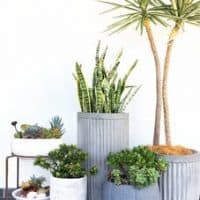Indoor Vegetable Garden (It’s Easy If You Do It Smart)
Table of Contents
Indoor Vegetable Garden Overview
Place your green thumb to work –and then save yourself a trip into the Farmer’s market–by developing your own vegetables, fruits, and other meals inside year-round.
To begin, you’re going to require a pot with drainage holes and specially designed indoor air soil. When some choices can rise in tiny planters, bigger veggies will call for large and deep containers, therefore, their origins have room to prosper.
And to make sure your soil drains correctly (no soggy baskets permitted!), it might be very helpful to DIY your own mix with the addition of some organic perlite into high-quality potting soil.
As soon as you’ve obtained your own supplies, end up sunny window (veggies will probably require at least 4-6 hours sunshine while meals will require at least 8-10 hours daily) and receive to pot.
Follow these hints, select from a number of our favorite choices below, and you are going to be harvesting your very own indoor plants in no time.
-
Scallions
Grow these candies onions then add them into dishes such as dill Scallions are fantastic for gardening novices since they are easy to look after and do not want as much sun as other veggies.
-
Radishes
“Radishes are proven to perform very well inside,” Miracle-Gro research pro Ashleigh Lemon informs CountryLiving.com.
This origin veggie will not require a bunch of mild, but it is going to require a heavy enough container big to house the growing bulbs.
-
Microgreens
Not just are microgreens amazingly easy to develop, they are Super healthful, too. In reality, microgreens are packaged with as much as 40 times greater vitamins and nutrition than completely grown plants and veggies.
(We advocate using these to high cakes and sandwiches!) Begin with a yummy mixture of baby spinach, beets, and arugula, and you’re going to have your very first crop only 2-3 weeks afterward.
-
Herbs
Herbs grow very well indoors, only be sure they are not overly Near a window during summertime (sunlight might cause wilting).
Take your choice from such foolproof choices: eucalyptus, rosemary, cilantro, chives, lavender, oregano, and parsley.
-
Potatoes
These flexible crops can be increased in fuss-free planter Pouches, even though they’ll require a good deal of light as soon as they’re created.
You will also have to split out quite a little space for Celtics because they could grow pretty significant.
An Inside Vegetable Garden?
Houseplants and herb gardens are well-known as common plants that are fully grown inside.
However, they’re not the sole plants that may be fully grown inside. By exploiting the correct containers and having the power to mimic the best growing conditions you’ll be able to even have an interior vegetable patch.
The advantages of getting one transcend the change of state of your home or the relief you get from husbandry.
Keep Reading Indoor Vegetable Garden
However, you’ll be able to additionally choose your own vegetables right in your room.
Carrots, tomatoes, and radishes are 3 of the simplest vegetable to grow inside. Every grows otherwise and can want separate containers however with some analysis this can be not a drag.
A south-facing window is that the best supply of natural daylight for your vegetables to grow in. If you are doing not have the correct exposure, you’ll be able to invest in a synthetic bulb to produce supplemental lightweight.
An Inside Vegetable Garden? It’s Easy If You Do It Smart
As with any instrumentation you decide on to grow plants in, ensuring there’s enough evacuation is vital. If your plants sit in an excessive amount of water they’re not getting to survive.
If the pots you decide on don’t have holes within the bottom make certain to place a layer of gravel or wood chips to permit the water to run out of the soil. The flip aspect of this can be to not make sure the water doesn’t run out too quickly either.
When selecting the categories of vegetables to plant, follow equivalent pointers as you would for outdoors. On the seed packets.
It will provide recommendations once to plant. The number of sunshine and water that’s required and therefore the spacing necessities.
Tailor your water schedule in line with the condition of the soil, ensure it doesn’t get too dry or keep too wet either.
By the top of the summer or early fall, you must be ready to harvest the vegetables fully grown within your house.
4 Tips for Creating a Homemade Indoor Vegetable Garden
Creating a homemade indoor vegetable garden system is a great project to take on, whether you are doing it for fun or just love gardening. For this guide, all you need is a space in your home you are not currently using, and the following tips:
1. Space
Of course, space is important when planting a vegetable garden in your home. Depending on your project, you can use a small area in your kitchen or dedicate an entire room. This is as long as the area receives sufficient natural sunlight and has an optimum average temperature.
2. Vegetables
Once you find the space, you need to pick the vegetable or herb you will be planting. Lettuce is a very popular indoor vegetable choice because it is tasty and easy to start. Similarly, Arugula germinates quickly and thrives in cool environments.
3. Sunlight
Your vegetable garden system will appreciate some natural sunlight, especially in the morning. If you can, place your plants next to an East-facing window. Still, if you don’t have space that will allow this, worry not; your vegetables will also do well under grow lights.
4. Water
As a caring gardener, you may want to water your vegetables every three hours. However, this can backfire because vegetables and herbs don’t respond well to overwatering. It is best to water them thoroughly but less frequently.
Conclusion
Remember, different plants and cultivars have different growth requirements that depend on their biology. Before setting up your indoor vegetable garden system, learn everything you can about the vegetable you would like to plant.
Related Articles



